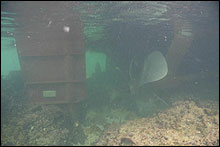Incident Response/Contingency Planning
The resource protection staff in the National Marine Sanctuaries are often the first on-scene personnel responding to emergency incidents in sanctuary waters. These types of emergencies include such incidents as vessel groundings, airplane crashes, and oil spills.
 Sanctuary staff help contact key federal, state, and local agencies; mobilize assets for response; and ensure that sensitive sanctuary resources are protected. Improving emergency preparedness and contingency planning remains one of the sanctuary program’s higher priorities. These activities are coordinated by resource protection staff because of the close association and inter-relatedness to prevention, preparedness, injury assessment, and enforcement. Sanctuary staff help contact key federal, state, and local agencies; mobilize assets for response; and ensure that sensitive sanctuary resources are protected. Improving emergency preparedness and contingency planning remains one of the sanctuary program’s higher priorities. These activities are coordinated by resource protection staff because of the close association and inter-relatedness to prevention, preparedness, injury assessment, and enforcement.
Two recent tools to improve incident response are SHIELDS and RUST.
SHIELDS
Sanctuaries Hazardous Incident Emergency Logistics Database System (SHIELDS) is a system of web-based contingency plans and tools, hosted on a secure Intranet. SHIELDS gives resource managers and their co-Trustees efficient access to policies, regulations, contingency plans, numerous NOAA databases, Geographic Information System data and maps, charts and images providing on-demand information for making critical decisions about environmental tradeoffs during a response. It has also been found it to be a useful tool for other purposes, including tracking safety training, providing information for environmental assessments, management plan reviews, permitting information, and historical and cultural resources.
RUST
The Resources and UnderSea Threats (RUST) database, which is part of SHIELDS, is a new response tool that allows for the identification of potential oil spill sources. There are thousands of post World War II vessels within our coastal waters that are aging and corroding. Many of these vessels went down with significant amounts of fuel or other potentially harmful cargo on board. RUST is intended to help resource protection and maritime heritage staff identify, monitor, and assess the potential environmental threats associated with the corroding vessels. Other potential threats include pipelines, platforms, munitions, radioactive wastes, chemical warfare agents and industrial wastes.
|





